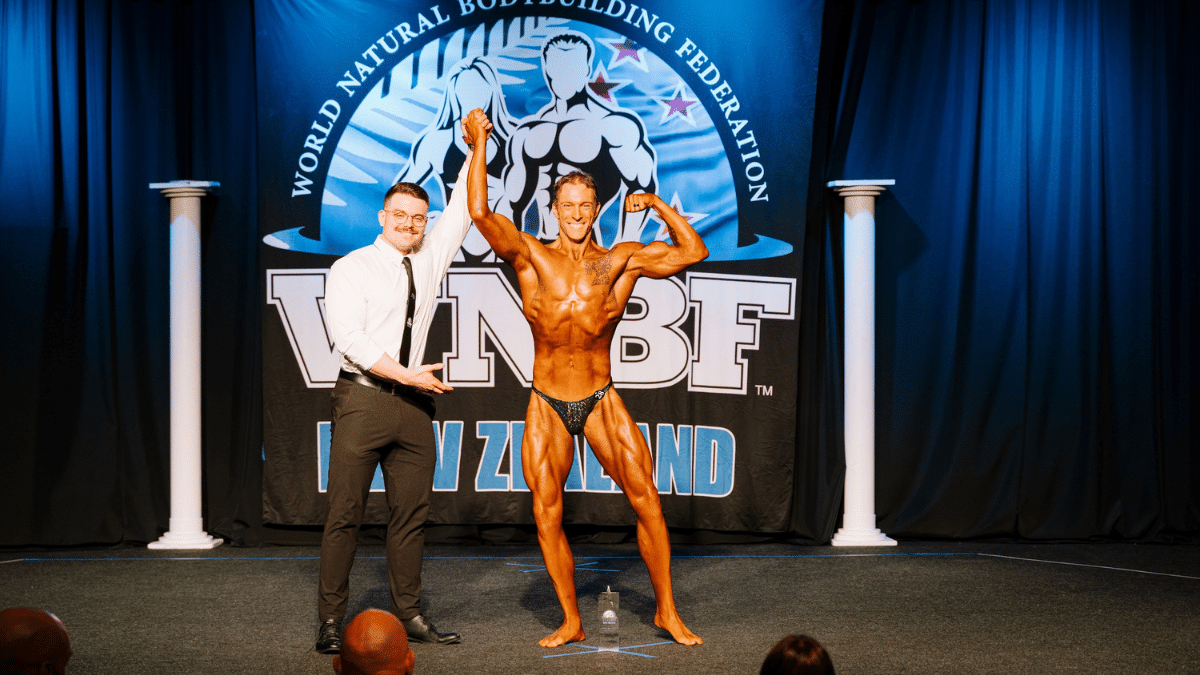Note: This piece was the MASS Research Review cover story for November 2023. If you want more content like this, subscribe to MASS.
Dr. Eric Helms’ kicked off his fifth competitive season in September with three competitions over consecutive weekends. This plan put him in the unique position of planning three back-to-back peak weeks, a prospect that would terrify a lot of competitors. The purpose of a peak week is to optimize the competitor’s appearance on stage. Peaking regimens typically include making simultaneous adjustments to exercise programming, carbohydrate intake, electrolyte balance, and water intake.
The traditional approach to peaking aims to decrease subcutaneous water retention and increase intramuscular fluid retention (or muscle “fullness”). Practically, this generally includes a depletion phase, during which the competitor consumes a low calorie, low carbohydrate diet, followed by a carbohydrate loading phase in an attempt to super compensate glycogen storage. Typically, the next phase prescribes a moderate carbohydrate intake, water restriction, and, in some cases, decreased sodium and increased potassium.
In Dr. Helms’ experience, this practice doesn’t produce consistent results, as these variables are often changed haphazardly without any trial and error. Notably, some of these guidelines are borrowed from the enhanced bodybuilding world. While water restriction might be appropriate for competitors using performance-enhancing drugs that influence water retention, it doesn’t appear to be beneficial – and could be detrimental – for drug-free bodybuilders. There is an association between extracellular water and skinfold thicknesses, but dehydration can increase the retention of subcutaneous water. Early research suggested that each gram of muscle glycogen stored is accompanied by approximately 3–4g of intracellular water, but this is highly variable. A dehydrated competitor can look “flat,” despite having loaded carbohydrates.
Carbohydrate loading does appear to effectively increase muscle size. The competitor’s response to carbohydrate “refeeds” throughout prep can inform the ideal quantity of carbohydrates, along with length and timing of the peak week loading phase. A depletion phase is probably unnecessary since, at the end of prep, most competitors are actively dieting on very low calories. If an individual is already in a deficit, he/she is arguably already depleted. One simple approach to peaking, which he used for his back-to-back shows, is to have a heavy loading day the Thursday prior to the show followed by a tapered intake leading into the show. The Thursday heaviest loading day is typically ~4-8g carbohydrate per kg bodyweight, or 25%-30% higher than a typical refeed day. A typical taper on the following day might be ~25% lower, or about the same quantity of carbohydrates as a typical refeed day.
Individuals on very low calorie diets typically consume a lot of fiber to promote satiety, which draws water into the intestinal tract. Since fiber can’t be stored as glycogen, it should be minimized during the carbohydrate loading phase (<20g day). Sodium can be helpful on competition day for some individuals to acutely boost blood pressure and improve vascularity in response to a pump-up. However, the response to sodium should be tested beforehand, as this is not beneficial for everyone.
Bodybuilders competing in consecutive weekly shows should be conservative about the post-show meal. Given that most individuals don’t eat a ton in the 1-2 meals leading into a morning or afternoon stage appearance on show day (typically ~700-800 kcals, in Dr. Helms’ case), there is room to consume a decent sized – albeit reasonable – celebratory meal. He recommends focusing on the experience and the social engagement, as opposed to eating everything on the menu. Remember, you are about to enter another peak week!
While the peaking process is generally somewhat reproducible from show to show, it’s important to remember that you’re dealing with a dynamic system, a lot of assumptions, and a changing environment. It’s critical to accept a level of uncertainty. Finally, this process is psychologically challenging, and it can be difficult for even the most seasoned competitor to objectively evaluate his/her physique. It’s extremely valuable to lean on a coach or a fellow competitor to guide you through peak week, assess your physique under consistent lighting conditions with and without the spray tan, and help you make decisions that will prepare you to bring your best look to the stage.
Download this video | Download audio only | Stream this audio
Articles mentioned in the discussion
- When Wet Looks Dry: a Deep Dive into a Bodybuilding Peak Week (MASS subscription required)
- The Science of Peaking (MASS subscription required)
- Now We Know: Carb Loading Works for Bodybuilding (MASS subscription required)
- Can Bodybuilders Change Their Intra-To-Extracellular Water Ratio During Peak Week? (MASS subscription required)
- How Do Non-Tested Bodybuilders Peak (MASS subscription required)
- The First Bodybuilding Refeed Research (MASS subscription required)
- Intermittent Energy Restriction Attenuates the Loss of Fat Free Mass in Resistance Trained Individuals. A Randomized Controlled Trial
Get more content like this
This piece was the cover story for the November 2023 issue of MASS Research Review. If you’d like to read the full, 78-page November issue (and dive into the MASS archives), you can subscribe to MASS here.
Subscribers get a new edition of MASS each month. Each issue includes research review articles, video presentations, and audio summaries. PDF issues are usually around 100 pages long.




